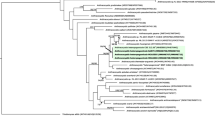Abstract
Ascomycetous black yeasts show adaptations to a wide array of environmental conditions. Dothideaceous black yeasts are mostly found on plant leaves, while among herpotrichiellaceous species there are numerous opportunists on humans.
Factors which are of ecological significance include the presence of melanin and carotene, formation of thick cell walls and meristematic growth, presence of yeast-like phases, presence of additional forms of conidiogenesis, thermo- and osmotolerance, adhesion, hydrophobicity, production of extracellular polysaccharides, siderophores and acidic or alkaline secondary metabolites.
The potential pathogenicity of a species is partly determined by its natural ecological niche. Dothideaceous black yeasts are osmotolerant rather than pathogenic. Herpotrichiellaceous black yeasts probably have low competitive ability and are found in rather special niches as secondary saprophytes, e.g., on bacterial mats, on other fungi or in poor environments. Some species possibly utilize animal vectors for dispersal.
Similar content being viewed by others
References
Alviano CS, Farbiarz SR, Travassos LR, Angluster J & De Souza W (1992) Effect of environmental factors onFonsecaea pedrosoi morphogenesis with emphasis on sclerotic cells induced by propranolol. Mycopathologia 119: 17–23
Barenfanger J, Ramirez F, Tewari RP & Eagleton L (1989) Pulmonary phaeohyphomycosis in a patient with hemoptysis. Chest 95: 1158–1160
Braams J (1993) Ecological studies on the fungal microflora inhabiting historical sandstone monuments. Thesis, Oldenburg
Cooke WB (1959) An ecological life history ofAureobasidium pullulans (de Bary) Arnaud. Mycopath. Appl. 12: 1–45
De Cock AWAM (1993) Population biology ofHortaea werneckii based on mitochondrial DNA restriction patterns. Antonie van Leeuwenhoek (in press)
De Hoog GS (1979a) The black yeasts, II:Moniliella and allied genera. Stud. Mycol. 19: 1–90
De Hoog GS & Gerrits-van den Ende B (1992) Nutritional pattern and eco-physiology ofHortaea werneckii, agent of human tinea nigra. Antonie van Leeuwenhoek 62: 321–329
De Hoog GS & McGinnis MR (1987) Ascomycetous black yeasts. In: De Hoog GS, Smith MT & Weijman ACM (Eds) The expanding realm of yeast-like fungi (pp. 187–199). Elsevier, Amsterdam
De Hoog GS & Haase G (1993) Nutritional physiology and selective isolation ofExophiala dermatitidis. Antonie van Leeuwenhoek (in press)
Dixon DM, Shadomy HJ & Shadomy S (1980) Dematiaceous fungal pathogens isolated from nature. Mycopathologia 70: 153–161
Dixon DM & Polak-Wyss A (1991) The medically important dematiaceous fungi and their identification. Mycoses 34: 1–18
Durrell LW (1964) The composition and structure of walls of dark fungus spores. Mycopath. Mycol. Appl. 23: 339–345
Funk A (1985) Foliar fungi of Western trees. Can. Forest. Service, Victoria
Geis PA & Jacobs CW (1985) Polymorphism ofWangiella dermatitidis. In: Szaniszlo PJ (Ed.) Fungal dimorphism (pp. 205–233). Plenum, New York
Geis PA & Szaniszlo PJ (1984) Carotenoid pigments of the dematiaceous fungusWangiella dermatitidis. Mycologia 76: 268–273
Helander ML & Rantio-Lehtimäki A (1990) Effects of watering and simulated acid rain on quantity of phyllosphere fungi of birch leaves. Microb. Ecol. 19: 119–125
Kane J & Summerbell RC (1987) Sodium chloride as aid in identification ofPhaeoannellomyces werneckii and other medically important dematiaceous fungi. J. Clin. Microbiol. 25: 944–946
Kusenbach G, Skopnik H, Haase G, Friedrichs F & Döhmen H (1992)Exophiala dermatitidis pneumonia in cystic fibrosis. Eur. J. Pediatr. 151: 344–346
Matsumoto T, Padhye AA, Ajello L, Standard P & McGinnis MR (1984) Critical review of human isolates ofWangiella dermatitidis. Mycologia 76: 232–239
McGinnis MR, Schell WA & Carson J (1985)Phaeoannellomyces and the Phaeococcomycetaceae, new dematiaceous blastomycete taxa. Sabouraudia 23: 179–188
Moore AL, Joy A, Tom R, Gust D, Moore TA, Bensasson RV & Land EJ (1982) Photoprotection by carotenoids during photosynthesis: Motional dependence of intramolecular energy transfer. Science 216: 982–984
Müller E, Petrini O, Fisher PJ, Samuels GJ & Rossman AY (1987) Taxonomy and anamorphs of the Herpotrichiellaceae with notes on generic synonymy. Trans. Br. Mycol. Soc. 88: 63–74
Munk A (1956) On relations between ecologic and taxonomic aspects in the Pyrenomycetes. Sydowia, Beih. 1: 9–13
Naka W, Masuda M, Harada T & Nishikawa T (1987) Comparative mycological studies ofExophiala jeanselmei having a granular form with preserved strains ofE. jeanselmei andE. dermatitidis. Jap. J. Med. Mycol. 28: 250–257
Nishimura K, Miyaji M, Taguchi H & Tanaka R (1987) Fungi in bathwater and sludge of bathroom drainpipes. 1. Frequent isolation ofExophiala species. Mycopathologia 97: 17–23
Rippon JW (1988) Medical mycology, 3rd ed. Saunders, Philadelphia, 797 pp
Silva M (1957) The parasitic phase of the fungi of chromoblastomycosis: Development of sclerotic cells in vitro and in vivo. Mycologia 49: 318–331
Sigler L, Tsuneda A & Carmichael JW (1981)Phaeotheca andPhaeosclera, two new genera of Dematiaceous Hyphomycetes and a redescription ofSarcinomyces Lindner. Mycotaxon 12: 449–467
Sivanesan A (1984) The bitunicate Ascomycetes and their anamorphs. Cramer, Vaduz, 701 pp
Sugiyama J, Nagai K & Komagata K (1987) Ubiquinone systems in strains of species in the black yeast generaPhaeococcomyces, Exophiala, Hortaea, andRhinocladiella. J. Gen. Appl. Microbiol. 33: 197–204
Szaniszlo PJ, Hsieh PH & Marlowe JD (1976) Induction and ultrastructure of the multicellular (sclerotic) morphology inPhialophora dermatitidis. Mycologia 68: 117–130
Takeo K & De Hoog GS (1991) Karyology and hyphal characters as taxonomic criteria in ascomycetous black yeasts and related fungi. Antonie van Leeuwenhoek 60: 35–42
Tanaka R, Nishimura K & Miyaji M (1990)Hortaea werneckii isolated from house dust. Jap. J. Med. Mycol. 31: 23–28
Tintelnot K, De Hoog GS, Thomas E, Steudel W-I, Huebner K & Seeliger HPR (1991) Cerebral phaeohyphomycosis caused by anExophiala species. Mycoses 34: 239–244
Titze A & De Hoog GS (1990)Capnobotryella renispora on roof tile. Antonie van Leeuwenhoek 58: 265–269
Uijthof JMJ, De Cock AWAM, De Hoog GS, Quint WGV & Van Belkum A (1993) PCR-mediated genotyping ofHortaea werneckii, causative agent of tinea nigra. J. Clin. Microbiol. (in press)
Yamada Y, Sugihara K, Van Eijk GW, Roeijmans HJ & De Hoog GS (1989). Coenzyme Q systems in ascomycetous black yeasts. Antonie van Leeuwenhoek 56: 349–356
Wheeler MH & Bell AA (1988) Melanins and their importance in pathogenic fungi. Curr. Topics Med. Mycol. 2: 338–387
Author information
Authors and Affiliations
Rights and permissions
About this article
Cite this article
de Hoog, G.S. Evolution of black yeasts: possible adaptation to the human host. Antonie van Leeuwenhoek 63, 105–109 (1993). https://doi.org/10.1007/BF00872386
Received:
Accepted:
Issue Date:
DOI: https://doi.org/10.1007/BF00872386




